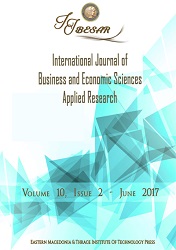Railway Development in Light of Market Needs: A SWOT Analysis of the Rail Transport Markets in the Visegrád Four Countries
Railway Development in Light of Market Needs: A SWOT Analysis of the Rail Transport Markets in the Visegrád Four Countries
Author(s): Bálint L. TóthSubject(s): Economic policy, International relations/trade, Economic development, Transport / Logistics
Published by: Τεχνολογικό Εκπαιδευτικό Ίδρυμα Ανατολικής Μακεδονίας και Θράκης
Keywords: Transport; railways; integration; development; statistics; SWOT;
Summary/Abstract: Purpose: This paper intends to provide a comparative analysis of the Czech, the Hungarian, the Polish and the Slovak railway development strategies in light of the evolution of transport needs, travel habits, freight volumes, and regional business relations. By offering a general SWOT analysis through real-life examples, the paper shall contribute to the better understanding of railway development trends in the Visegrád states. Design/methodology/approach: The research’s scope is to identify the real motives and triggers of railway modernization and construction policies in the Visegrád Four countries (the Czech Republic – “Czechia”, Hungary, Poland and the Slovak Republic – “Slovakia”). Through the quantitative research of international, national and corporate transport databases and surveys, as well as the analysis of EU strategies and V4 presidency programs, the paper concludes that the regional rail transport market has clear advantages with constantly growing traffic and every time more actively trading companies. Findings: The study found that the V4 railway integration is in major part powered by the EU’s development funds and communitarian regulations support the competitiveness of rail services in the region. However, the efficiency of train services ranks below the communitarian medium level in most of the V4 states. Therefore, if Visegrád countries wish to close up with their western neighbors, the frequency, the speed and the quality of train services must improve. Research limitations/implications: As this study provides a general insight to Visegrád railway development strategies from a market perspective, future researches might focus on the political motivations of such infrastructure projects. Further papers might also investigate the possible impacts of railway developments on the employment, cultural and business relations, travel habits, tourism, and environmental protection in the Visegrád area. Originality/value: By offering a general SWOT analysis through real-life examples (dated from these countries’ EU accession), the paper shall contribute to the better understanding of railway development trends in the Visegrád states. The research primarily focuses on the relationship, causal mechanisms, interactions, and dynamics between infrastructure investments and the concrete needs of the transport sectors of these states. The analysis has multiple levels including that of state actors, sub-state regional entities, railway undertakings, and transport corridors. In order to provide a global European view on the evolution of rail transportation, V4 statistical data is compared to European average numbers all through this study.
Journal: International Journal of Business and Economic Sciences Applied Research (IJBESAR)
- Issue Year: 13/2020
- Issue No: 3
- Page Range: 32-44
- Page Count: 13
- Language: English

